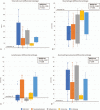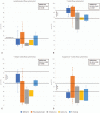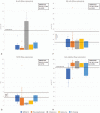Differential cytology profiles in bronchoalveolar lavage (BAL) in COVID-19 patients: A descriptive observation and comparison with other corona viruses, Influenza virus, Haemophilus influenzae, and Pneumocystis jirovecii
- PMID: 33429831
- PMCID: PMC7793419
- DOI: 10.1097/MD.0000000000024256
Differential cytology profiles in bronchoalveolar lavage (BAL) in COVID-19 patients: A descriptive observation and comparison with other corona viruses, Influenza virus, Haemophilus influenzae, and Pneumocystis jirovecii
Abstract
Brochoalvelolar lavages (BALs) from patients suffering from hospitalized infections with SARS-CoV-2, other corona viruses (human coronavirus (HCoV)-229E, HCoV-OC43, HCoV-NL63, and HCoV-HKU1), Influenza virus type A and B, Haemophilus influenzae and Pneumocystis jirovecii were compared cytopathologically.The aim of the study was to evaluate if the cellular profile detectable in BAL may be specific for the respective pathogens and could lead to diagnosis of COVID-19 even in the absence of PCR results.Differential cytology and flow cytometry datasets of 62 patients were observed and compared.We observed a significant association between individual cell pattern changes and the causing pathogen, but no general cell distribution pattern.The cytology pattern of the BAL fluid in COVID-19 is not specific enough to use it as a sole diagnostic criterion, although it may support clinical decision making.
Copyright © 2021 the Author(s). Published by Wolters Kluwer Health, Inc.
Conflict of interest statement
The authors have no funding and conflicts of interest to disclose.
Figures



References
MeSH terms
LinkOut - more resources
Full Text Sources
Other Literature Sources
Medical
Miscellaneous

